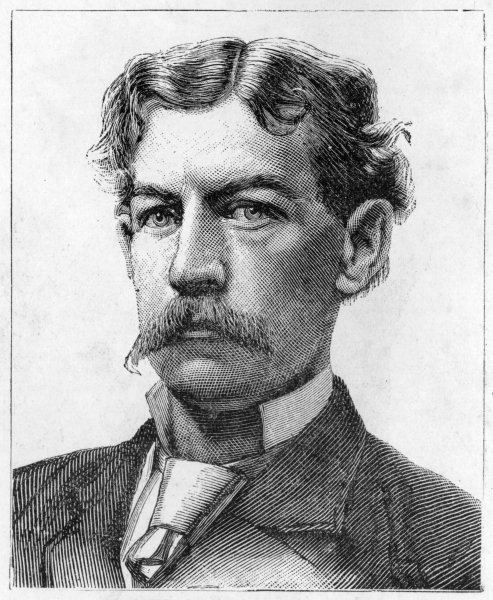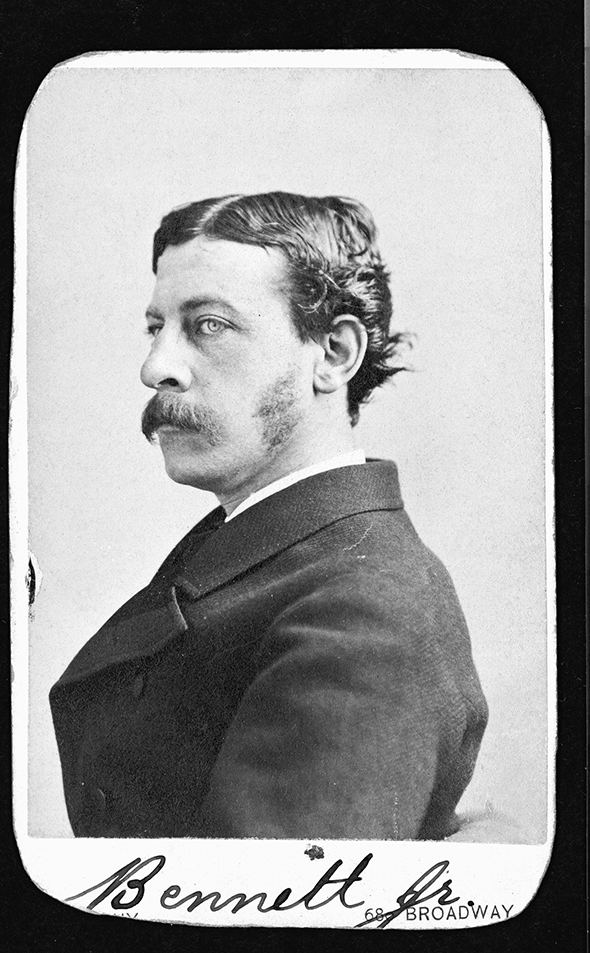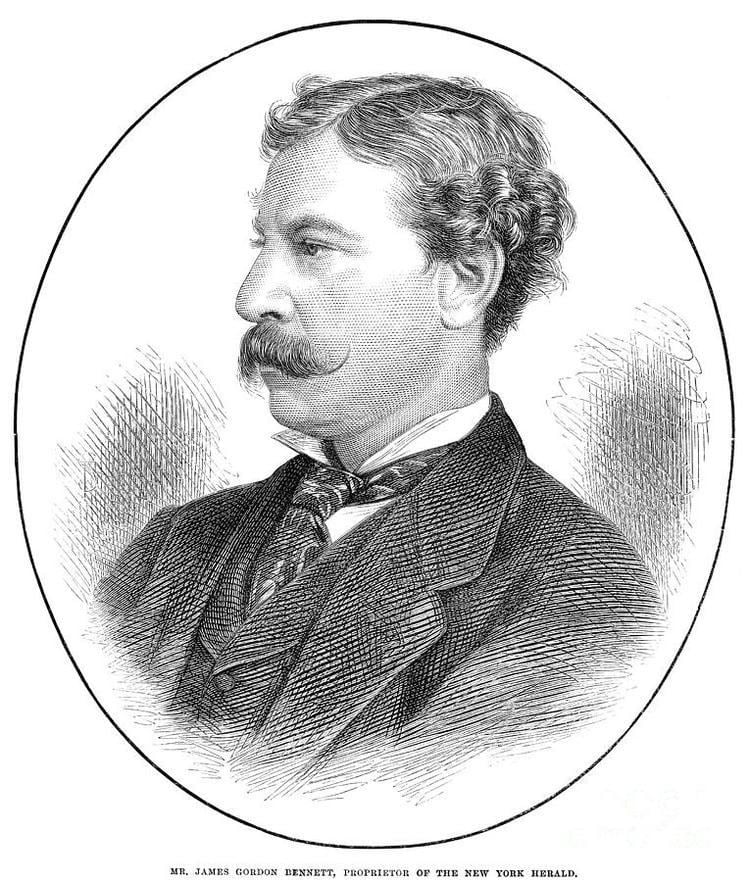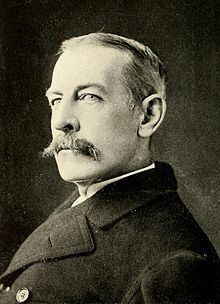Occupation Publisher Role Publisher | Name James Bennett, Spouse(s) Baroness de Reuter | |
 | ||
Born May 10, 1841 ( 1841-05-10 ) New York City Died May 14, 1918, Beaulieu-sur-Mer, France | ||
Parents James Gordon Bennett, Sr. | ||
James Gordon Bennett Jr. (May 10, 1841 – May 14, 1918) was publisher of the New York Herald, founded by his father, James Gordon Bennett Sr., who emigrated from Scotland. He was generally known as Gordon Bennett to distinguish him from his father. Among his many sports-related accomplishments he organized both the first polo match and the first tennis match in the United States, and he personally won the first trans-oceanic yacht race. He sponsored explorers including Henry Morton Stanley's trip to Africa to find David Livingstone, and the ill-fated USS Jeannette attempt on the North Pole.
Contents

Early life

Bennett was born on May 10, 1841 in New York City to James Gordon Bennett Sr. (1795–1872), the founder, editor and publisher of the New York Herald. He was educated primarily in France. In 1866, the elder Bennett turned control of the Herald over to him. Bennett raised the paper's profile on the world stage when he provided the financial backing for the 1869 expedition by Henry Morton Stanley into Africa to find David Livingstone in exchange for the Herald having the exclusive account of Stanley's progress.
Lifestyle

Bennett, like many of his social class, indulged in the "good life": yachts, opulent private railroad cars, and lavish mansions. He was the youngest Commodore ever of the New York Yacht Club.
Yachts

In 1861, Bennett volunteered his newly built schooner yacht, Henrietta, for the U.S. Revenue Marine Service during the Civil War. At the same time, Bennett was commissioned as a third lieutenant in the Revenue Marine Service (equivalent to an ensign in the U.S. Navy) and assigned to the U.S. Marine Revenue schooner Henrietta (the yacht he had loaned to the U.S. Government) beginning in June 1861. She patrolled Long Island until February 1862 when she was sent to Port Royal, South Carolina. On March 3, 1862, Bennett commanded the Henrietta as part of the fleet which captured Fernandina, Florida. Bennett and the Henrietta returned to civilian life in New York in May 1862.
In 1866, on a bet, he won the first trans-oceanic yacht race. The race was between three American yachts, the Vesta (owned by Pierre Lorillard IV), the Fleetwing (owned by George and Frank Osgood) and the Henrietta. Each yachtsman put up $30,000 in the winner-take-all wager.[1] They started off of Sandy Hook, New Jersey, on 11 December 1866 amid high westerly winds and raced to The Needles, the furthest westerly point on the Isle of Wight, famous for its lighthouse. Bennett's Henrietta won with a time of 13 days, 21 hours, 55 minutes.
He entertained guests aboard his steam-yacht "Namouna." American expatriate artist Julius LeBlanc Stewart painted several works set on the yacht.
Scandal
However, he often scandalized society with his flamboyant and sometimes erratic behavior. In 1877, he left New York for Europe after an incident that ended his engagement to socialite Caroline May. According to various accounts, he arrived late and drunk to a party at the May family mansion, then urinated into a fireplace (some say grand piano) in full view of his hosts.
Bennett's controversial reputation has been thought to have inspired, in the United Kingdom, the phrase "Gordon Bennett" as an expression of incredulity.
Move to Paris
Settling in Paris, he launched the Paris edition of the New York Herald, named The Paris Herald, the forerunner of the International Herald Tribune. He backed George W. De Long's voyage to the North Pole on the USS Jeannette via the Bering Strait. The ill-fated expedition led to the deaths from starvation of DeLong and 19 of his crew, a tragedy that only increased the paper's circulation. He was a co-founder of the Commercial Cable Company, a venture to break the Transatlantic cable monopoly held by Jay Gould.
Return to the US
Bennett returned to the United States and organized the first polo match in the United States at Dickel's Riding Academy at 39th Street and Fifth Avenue in New York City. He would help found the Westchester Polo Club in 1876, the first polo club in America. He established the Gordon Bennett Cup for international yachting and the Gordon Bennett Cup for automobile races. In 1906, he funded the Gordon Bennett Cup in ballooning (Coupe Aéronautique Gordon Bennett), which continues to this day. In 1909, Bennett offered a trophy for the fastest speed on a closed circuit for airplanes. The 1909 race in Rheims, France was won by Glenn Curtiss for two circuits of a 10 km rectangular course at an average speed of 46.5 miles per hour (74.8 km/h). From 1896 to 1914, the champion of Paris, USFSA football (soccer), received a trophy offered by Gordon Bennett.
Personal life
He did not marry until he was 73. His wife was Maud Potter, widow of George de Reuter, son of Julius Paul Reuter, founder of Reuters news agency. He died on May 14, 1918 in Beaulieu-sur-Mer, Alpes-Maritimes, France. Bennett is buried at the Cimetière de Passy.
Honors
Asteroid 305 Gordonia is named after him. He also has a street named for him near Chopin Airport in Warsaw, Poland. The Avenue Gordon Bennett in Paris, with Stade de Roland Garros site of the French Open, is named after his father.
